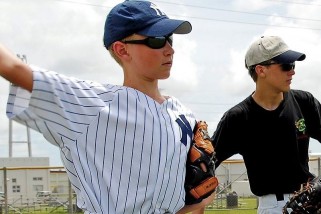BreakingModern - A Missouri grand jury’s decision not to indict Ferguson police officer Darren Wilson in the August 9th shooting death of Michael Brown, an unarmed African-American teenager, has sparked another round of riots in the St. Louis suburb along with militant protests across the United States.
This leads to all the obvious questions — questions so obvious that they generally aren’t getting answered in all the fury surrounding the emotional, heated debates about police violence, racism, protest, profiling and rioting in Ferguson, Mo. Here’s what you need to know about what’s going on now in Ferguson.
Haven’t there been police shootings, and protests, before?
There sure have — many of them. According to the United States Department of Justice, more than 4,800 Americans were shot to death by cops between 2003 and 2009. Blacks and Hispanics are disproportionately more likely to be shot by the police than white suspects. In recent years, local police departments reported an average of 96 blacks shot to death by white policemen each year.

Many of those shootings were justifiable. Harder for cops to explain is what seems to fit into a here-we-go-again narrative: police using semiautomatic pistols to kill unarmed young black men.
High-profile cases include Kendrec McDade, killed by Pasadena PD in 2012 over an armed robbery (McDade only had a cellphone); Cleveland resident Timothy Russell, shot along with his companion in their car 137 times (again, no weapon); and Amadou Diallo, who was approached by officers at his home in the Bronx and shot 41 times (cops said they thought his billfold, which contained ID he was trying to show them, was a gun).
So then why is what’s happening in Ferguson such a big deal?
This is how pattern detection works: it takes a long drip, drip, drip before people notice the water on the floor.
Black Americans have long felt that they are unfairly targeted for harassment and abuse by law enforcement (and frankly, they’re right). Residents of Ferguson, a majority black municipality whose police department is mostly white, have long chafed in their interactions with the cops. In 2009, in a case of mistaken identity, a 52-year-old man was badly beaten in police custody and then — get this — indicted under one charge: damage to police property, namely his blood on the uniforms of the thug cops who pounded him.
What makes the Michael Brown case significant is its impact on the media.
With occasional exceptions such as the national soul searching on police brutality that followed riots in reaction to the videotaped beating of Rodney King by Los Angeles police, cop-on-black violence has been a secret of sorts, widely understood to be routine in black communities and mostly disbelieved by whites, whose dealings with the police are less frequent and less confrontational. Half a century after the Civil Rights Act, the overwhelming majority of white Americans have no black friends or acquaintances whatsoever. As John Edwards would say, blacks and whites are living in two Americas.
Race and police violence were teed up for reporters as a Big National Issue after the 2012 shooting of Trayvon Martin, an unarmed 17-year-old by a community watch member in Florida. The shooter, George Zimmerman, wasn’t indicted. Adding to blacks’ sense that justice had been denied was Zimmerman’s bizarre, violent behavior in the year following the incident.
Coming just over a year later, the Brown killing in Ferguson looked like here-we-go-again not just to blacks, but to editors and producers in the national media.
Why now?
Activists have made relentless use of Twitter and other social media platforms to keep the Ferguson case alive in the press and on broadcast outlets. But there are other aspects of the Ferguson case that make it particularly appealing to media gatekeepers:
The Heartland effect: Stuff that happens in the Midwest resonates more with national media than in unusual, “weird” places like south Florida or east L.A. Right smack in the middle of the country — there’s no denying this is a “mainstream” story.
Confusing demographics: Ferguson is a suburb, but mostly black (we think of suburbs as white). It’s mostly black, but not a slum (despite portrayals in the media). Media types are drawn to this sort of incongruity like moths to flames.
For the media, this was the final “drip.” Like a school of fish or a flock of birds that knows how to follow itself, the media swarm intuitively senses that Ferguson is one dead black kid too far.
Stuff is burning. Yeah, yeah, we all deplore violence — but TV producers love that footage of burning police cruisers lighting up the night. It’s like Beirut, but right here in America — war correspondency without the cost of international travel! True, riots are an expression of rage born of frustration after years of seeing their complaints about racial profiling and other indignities ignored by the political class.
Riots are also a lot more effective at garnering attention than politely-worded letters to the editor. It’s a shame, but it’s true.
Cover image: Jamelle Bouie [CC-BY-2.0], via Wikimedia Commons.







![Pete Rose Continues to be Out of Step with Major League Baseball [commentary]](../wp-content/uploads/2015/10/HEADER2-321x214.png)



![The Legend of Zelda: The Wind Waker HD [review]](../wp-content/uploads/2015/10/HEADER-321x214.jpg)
![Madden NFL Mobile [review]](../wp-content/uploads/2015/09/header3-60x60.jpg)

![Call of Juarez: Bound in Blood [review]](../wp-content/uploads/2015/09/HEADER--60x60.jpg)
![Command & Conquer: Red Alert 3 [review]](../wp-content/uploads/2015/09/HEADER-60x60.jpg)
November 25, 2021
Thanks for this Ted Rall. Seems violence is the locals only recourse.
November 25, 2021
Well articulated piece Ted Rall! The media has taken this one by storm, but it is not the first, that is for sure. I remembering seeing this video when the Ferguson news first appeared: http://www.msnbc.com/melissa-harris-perry/watch/the-deaths-of-black-men-in-america-318795331819
Not sure what should be done, but I for one understand the rioting…